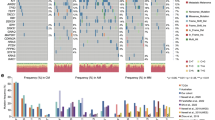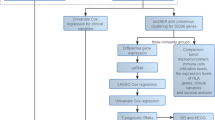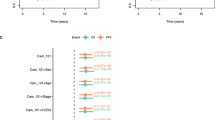Abstract
The expression of p21, p53 and proliferating cell nuclear antigen (PCNA) was analysed by immunohistochemistry in a consecutive series of 369 clinical stage I cutaneous malignant melanoma patients. Correlation of the detected expression levels with each other, with clinicopathological data and with melanoma survival were statistically evaluated. p21 expression was significantly associated with p53 and PCNA expression levels. In addition, high levels of p53 and PCNA were significantly interrelated. Tumour thickness, recurrent disease, high TNM category and older (≥ 55 years) age at diagnosis were inversely associated with p21 expression. Gender, bleeding, tumour thickness, Clark’s level of invasion, TNM category and p53 index were all important predictors of both recurrence-free and overall survival of melanoma. In Cox’s multivariate analysis including 164 patients with a complete set of data, only high tumour thickness and bleeding predicted poor recurrence-free survival (P= 0.0042 and 0.0087 respectively) or overall survival (P= 0.0147 and 0.0033 respectively). Even though elevated p21 expression may be associated with more favourable prognosis in clinical stage I cutaneous melanoma, our results suggest that cell cycle regulatory effects of p21 can be overcome by some other and stronger, partly yet unknown, mechanisms.
Similar content being viewed by others
Article PDF
Change history
16 November 2011
This paper was modified 12 months after initial publication to switch to Creative Commons licence terms, as noted at publication
References
Aaltomaa, S., Lipponen, P., Papinaho, S. & Syrjänen, K. (1993). Proliferating-cell nuclear antigen (PC10) immunolabelling and other proliferation indices as prognostic factors in breast cancer. J Cancer Res Clin Oncol, 119, 288–294.
Borresen, A. L., Hovig, E., Smith Sorensen, B., Malkin, D., Lystad, S., Andersen, T. I., Nesland, J. M., Isselbacher, K. J. & Friend, S. H. (1991). Constant denaturant gel electrophoresis as a rapid screening technique for p53 mutations. Proc Natl Acad Sci USA, 88, 8405–8409.
Breslow, A. (1970). Thickness, cross-sectional areas and depth of invasion in the prognosis of cutaneous melanoma. Ann Surg, 12, 902–908.
Chen, I-T, Smith, M. L., O’Connor, P. M. & Fornace, A. J. (1995). Direct interaction of Gadd45 with PCNA and evidence for competitive interaction of Gadd45 with p21Wafl/Cip1 with PCNA. Oncogene, 11, 1931–1937.
Clark Jr, W. H., From, L., Bernardino, E. A. & Mihm, M. C. (1969). The histogenesis and biologic behaviour of primary human malignant melanomas of the skin. Cancer Res, 29, 705–726.
Cox, D. R. (1972). Regression models and life tables with discussion. J Stat Soc B, 34, 187–192.
Deb, S., Jackson, C. T., Subler, M. A. & Martin, D. W. (1992). Modulation of cellular and viral promoters by mutant human p53 proteins found in tumour cells. J Virol, 66, 6164–6170.
Diab, S. G., Yu, Y. Y., Hilsenbeck, S. G., Allred, D. C. & Elledge, R. M. (1997). WAF1/CIP1 protein expression in human breast tumors. Breast Cancer Res Treat, 43, 99–103.
DiGiuseppe, J. A., Redston, M. S., Yeo, C. J., Kern, S. E. & Hruban, R. H. (1995). p53-independent expression of the cyclin-dependent kinase inhibitor p21 in pancreatic carcinoma. Am J Pathol, 147, 884–888.
Doglioni, C., Pelosio, P., Laurino, L., Macri, E., Meggiolaro, E., Favretti, F. & Barbareschi, M. (1996). p21/WAF1/CIP1 expression in normal mucosa and in adenomas and adenocarcinomas of the colon: its relationship with differentiation. J Pathol, 179, 248–253.
El-Deiry, W. S., Tokino, T., Velculescu, V. E., Levy, D. B., Parsons, R., Trent, J. M., Lin, D., Mercer, W. E., Kinzler, K. W. & Vogelstein, B. (1993). WAF1, a potential mediator of p53 tumour suppression. Cell, 75, 817–825.
El-Deiry, W. S., Tokino, T., Waldman, T., Oliner, J. D., Velculescu, V. E., Burrell, M., Hill, D. E., Healy, E., Rees, J. L., Hamilton, S. R., Kinzler, K. W. & Vogelstein, B. (1995). Topological control of p21WAF1/cip1 expression in normal and neoplastic tissues. Cancer Res, 55, 2910–2919.
Flores-Rozas, H., Kelman, Z., Dean, F. B., Pan, Z. Q., Harper, J. W., Elledge, S. J., O’Donnell, M. O. & Hurwitz, J. (1994). Cdk-interacting protein I directly binds with proliferating cell nuclear antigen and inhibits DNA replication catalyzed by the DNA polymerase delta holoenzyme. Proc Natl Acad Sci USA, 91, 8655–8659.
Gelsleichter, L., Gown, A. M., Zarbo, R. J., Wang, E. & Coltera, M. D. (1995). P53 and mdm-2 expression in malignant melanoma: an immunohistochemical study of expression of p53, mdm-2, and markers of cell proliferation in primary versus metastatic tumours. Modern Pathol, 8, 530–535.
Hall, P. A. & Lane, D. P. (1994). p53 in tumour pathology: can we trust immunohistochemistry? – Revisited!. J Pathol, 172, 1–4.
Harada, N., Gansauge, S., Gansauge, F., Gause, H., Shimoyama, S., Imaizumi, T., Mattfeld, T., Schoenberg, M. H. & Beger, H. G. (1997). Nuclear accumulation of p53 correlates significantly with clinical features and inversely with the expression of the cyclin-dependent kinase inhibitor p21WAF1/CIP1 in pancreatic cancer. Br J Cancer, 76, 299–305.
Harper, J. W., Adami, G. R., Wei, N., Keyomarsi, K. & Elledge, S. J. (1993). The p21-Cdk-interacting protein Cip1 is a potent inhibitor of G1 cyclin-dependent kinases. Cell, 75, 805–816.
Hiyama, H., Iavarone, A., LaBaer, J. & Reeves, S. A. (1997). Regulated ectopic expression of cyclin D1 induces transcriptional activation of the cdk inhibitor p21 gene without altering cell cycle progression. Oncogene, 14, 2533–2542.
Jiang, H., Lin, J., Su, Z. Z., Herlyn, M., Kerbel, R. S., Weissman, B. E., Welch, D. R. & Fisher, P. B. (1995). The melanoma differentiation-associated gene mda-6, which encodes the cyclin-dependent kinase inhibitor p21, is differentially expressed during growth, differentiation and progression in human melanoma cells. Oncogene, 10, 1855–1864.
Jung, J. M., Bruner, J. M., Ruan, S., Langford, L. A., Kyritsis, A. P., Kobayashi, T., Levin, V. A. & Zhang, W. (1995). Increased levels of p21WAF1/Cip1 in human brain tumors. Oncogene, 11, 2021–2028.
Kaplan, E. L. & Meier, P. (1958). Nonparametric estimation from incomplete observations. J Am Stat Assoc, 53, 457–481.
Lassam, N. J., From, L. & Kahn, H. J. (1993). Overexpression of p53 is a late event in the development of malignant melanoma. Cancer Res, 53, 2235–2238.
Maelandsmo, G. M., Holm, R., Fodstad, Ø, Kerbel, R. S. & Florenes, V. A. (1996). Cyclin kinase inhibitor p21WAF1/CIP1 in malignant melanoma. Am J Pathol, 149, 1813–1822.
Melhem, M. F., Law, J. C., El-Ashmawy, L., Johnson, J. T., Landreneau, R. J., Srivastava, S. & Whiteside, T. L. (1995). Assessment of sensivity and specifity of immunohistochemical staining of p53 in lung and head and neck cancers. Am J Pathol, 146, 1170–1177.
Michieli, P., Chedid, M., Lin, D., Pierce, J. H., Mercer, W. E. & Givol, D. (1994). Induction of WAF1/CIP1 by a p53-independent pathway. Cancer Res, 54, 3391–3395.
Moll, U. M., Riou, G. & Levine, A. J. (1992). Two distinct mechanisms alter p53 in breast cancer: mutation and nuclear exclusion. Proc Natl Acad Sci USA, 89, 7262–7266.
Nadal, A., Jares, P., Cazorla, M., Fernandez, P. L., Sanjuan, X., Hernandez, L., Pinyol, M., Aldea, M., Mallofre, C., Muntane, J., Traserra, J., Campo, E. & Cardesa, A. (1997). p21WAF1/Cip1 expression is associated with cell differentiation but not with p53 mutations in squamous cell carcinomas of the larynx. J Pathol, 183, 156–163.
Naresh, K. N., O’Conor, G. T., Soman, C. S., Johnson, J., Advani, S. H., Magrath, I. T. & Bhatia, K. G. (1997). A study of p53 protein, proliferating cell nuclear antigen, and p21 in Hodgkin’s disease at presentation and relapse. Hum Pathol, 28, 549–555.
Nishio, M., Koshikawa, T., Kuroishi, T., Suyama, M., Uchida, K., Takagi, Y., Washimi, O., Sugiura, T., Ariyoshi, Y., Takahashi, T., Ueda, R. & Takahashi, T. (1996). Prognostic significance of abnormal p53 accumulation in primary, resected non-small-cell lung cancers. J Clin Oncol, 14, 497–502.
Ory, K., Legros, Y., Auguin, C. & Soussi, T. (1994). Analysis of the most representative tumour-derived p53 mutants reveals that changes in protein conformation are not correlated with loss of transactivation or inhibition of cell proliferation. EMBO J, 13, 3496–3504.
Podust, V. N., Podust, L. M., Goubin, F., Ducommun, B. & Hubscher, U. (1995). Mechanism of inhibition of proliferating cell nuclear antigen-dependent DNA synthesis by the cyclin-dependent kinase inhibitor p21. Biochemistry, 34, 8869–8875.
Ro, Y. S., Cooper, P. N., Lee, J. A., Quinn, A. G., Harrison, D., Lane, D., Horne, C. H., Rees, J. L. & Angus, B. (1993). p53 protein expression in benign and malignant skin tumours. Br J Dermatol, 128, 237–241.
Sparrow, L. E., English, D. R., Heenan, P. J., Dawkins, H. J. & Taran, J. (1995). Prognostic significance of p53 over-expression in thin melanomas. Melanoma Res, 5, 387–392.
Talve, L., Kainu, J., Collan, Y. & Ekfors, T. (1996). Immunohistochemical expression of p53 protein, mitotic index and nuclear morphometry in primary malignant melanoma of the skin. Pathol Res Pract, 192, 825–833.
Tron, V. A., Tang, L., Yong, W. P. & Trotter, M. J. (1996). Differentiation-associated overexpression of the cyclin-dependent kinase inhibitor p21waf-1 in human cutaneous squamous cell carcinoma. Am J Pathol, 149, 1139–1146.
Trotter, M. J., Tang, L. & Tron, V. A. (1997). Overexpression of the cyclin-dependent kinase inhibitor p21waf-1/CIP1 in human cutaneous malignant melanoma. J Cutan Pathol, 24, 265–271.
UICC (1987). TNM Classification of Malignant Tumours, 4th edn., Springer-Verlag, Berlin; pp. 88–90.
Vidal, M. J., Loganzo, F., de Oliveira, A. R., Hayward, N. K. & Albino, A. P. (1995). Mutations and defective expression of the WAF1 p21 tumour-suppressor gene in malignant melanomas. Melanoma Res, 5, 243–250.
Vogt, T., Zipperer, K. H., Vogt, A., Holzel, D., Landthaler, M. & Stolz, W. (1997). p53-protein and Ki-67-antigen expression are both reliable biomarkers of prognosis in thick stage I nodular melanomas of the skin. Histopathology, 30, 57–63.
Vojtesek, B., Bontek, J., Midgley, C. A. & Lane, D. P. (1992). An immunochemical analysis of human p53: new monoclonal antibodies and epitope mapping using recombinant p53. J Immunol Methods, 51, 237–244.
Waga, S., Hannon, G. J., Beach, D. & Stillman, B. (1994). The p21 inhibitor of cyclin-dependent kinases controls DNA replication by interaction with PCNA. Nature, 369, 574–578.
Wakasugi, E., Kobayashi, T., Tamaki, Y., Ito, Y., Miyashiro, I., Komoike, Y., Takeda, T., Shin, E., Takatsuka, Y., Kikkawa, N., Monden, T. & Monden, M. (1997). p21(Waf1/Cip1) and p53 protein expression in breast cancer. Am J Clin Pathol, 107, 684–691.
Weiss, J., Heine, M., Körner, B., Pilch, H. & Jung, E. G. (1995). Expression of p53 protein in malignant melanoma: clinicopathological and prognostic implications. Br J Dermatol, 133, 23–31.
Wynford-Thomas, D. (1992). P53 in tumour pathology: can we trust immunohistochemistry?. J Pathol, 166, 329–330.
Yamamoto, M., Takahashi, H., Saitoh, K., Horikoshi, T. & Takahashi, M. (1995). Expression of the p53 protein in malignant melanomas as a prognostic indicator. Arch Dermatol Res, 287, 146–151.
Yasui, W., Akama, Y., Kuniyasu, H., Yokozaki, H., Semba, S., Shimamoto, F. & Tahara, E. (1996). Expression of cyclin-dependent kinase inhibitor p21WAF1/CIP1 in non-neoplastic mucosa and neoplasia of the stomach: relationship with p53 status and proliferative activity. J Pathol, 180, 122–128.
Zeng, Y-X & El-Deiry, W. S. (1996). Regulation of p21WAF1/CIP1 expression by p53-independent pathways. Oncogene, 12, 1557–1564.
Zeng, Y-X, Somasundaram, K. & El-Deiry, W. S. (1997). AP2 inhibits cancer cell growth and activates p21WAF1/CIP1 expression. Nature Genet, 15, 78–82.
Author information
Authors and Affiliations
Rights and permissions
From twelve months after its original publication, this work is licensed under the Creative Commons Attribution-NonCommercial-Share Alike 3.0 Unported License. To view a copy of this license, visit http://creativecommons.org/licenses/by-nc-sa/3.0/
About this article
Cite this article
Karjalainen, J., Eskelinen, M., Kellokoski, J. et al. p21WAF1/CIP1 expression in stage I cutaneous malignant melanoma: its relationship with p53, cell proliferation and survival. Br J Cancer 79, 895–902 (1999). https://doi.org/10.1038/sj.bjc.6690143
Received:
Revised:
Accepted:
Published:
Issue date:
DOI: https://doi.org/10.1038/sj.bjc.6690143
Keywords
This article is cited by
-
Immunohistochemical Expression of p16, p21, p27 and Cyclin D1 in Oral Nevi and Melanoma
Head and Neck Pathology (2012)
-
Melanoma biomarkers: current status and vision for the future
Nature Clinical Practice Oncology (2009)
-
Spitz nevi and atypical Spitz nevi/tumors: a histologic and immunohistochemical analysis
Modern Pathology (2005)
-
Transcription factors and other dysregulated proteins in melanoma prognosis
Current Oncology Reports (2001)
-
p21/WAF1 expression in human colorectal carcinoma: association with p53, transcription factor AP-2 and prognosis
British Journal of Cancer (1999)



